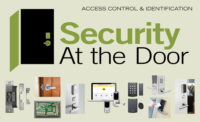Electronic door hardware and locks are a critical piece of any access control installation today. They are literally on the front lines of security, around the perimeter door. Once the purview of the locksmith and electrician, these components are increasingly being designed, spec’d and installed by security integrators. With the shift to IP networks, wireless architectures and Power over Ethernet (PoE), there is much to learn and know about these elements.
Manufacturers of the equipment are always a main source of information and guidance; but security distributors have their own important role in the equation. SDM spoke with four major distributors — David Cronk, PSP CRL, technical director-physical security at Anixter Inc., Glenview, Ill.; Bill Smoyer, national sales manager, Access Hardware Supply, San Leandro, Calif.; Kate Rose, senior product manager, access control and communications, ADI, Melville, N.Y.; and Tracey Boucher, vice president, vendor business and operations, ScanSource Networking and Security, Greenville, S.C. — about the trends they are seeing in electronic locks and door hardware; challenges they see for dealers and integrators; and the role distributors play in helping the channel deliver the best solutions to their customers.

David Cronk

Bill Smoyer

Kate Rose

Tracey Boucher
SDM: What are the latest trends in security locks and door hardware?
Cronk: I would like to say that we have seen quantum leaps in the electronic door locking hardware market, but we have not. However, we have seen many micro-evolutionary changes that are worth getting excited about. Electronic door locking hardware is now including features such as built-in requests to exit; power consumption requirements continue to decrease; intelligent multifunctional locks … are gaining momentum as a standard; and secure wireless communication between the lock and the access controller using a panel interface is eliminating the need to run wires to the door.
Boucher: The shift to IP in the access control world is the biggest trend we are seeing right now. The possibilities of access via mobile devices with Bluetooth technology are very exciting. There will be a measureable, positive impact due to this shift, not only with installations but the scalability of the entire solution.
Smoyer: What we see is that when (electronic lock) manufacturers have done integrations with the access control manufacturers those partnerships seem to be strengthening. ... Integrations have added additional tools in [security integrators’] bags.
Rose: Managed access control solutions are a newer trend, in distribution, which can allow an integrator to manage an end user site for a monthly fee using the RMR model from other security segments. Mobile credential adoption has also been on the rise in the past two years.
SDM: How have these trends changed things for security integrators or their end users?
Boucher: The expectation of the market has gone up. We hear from our dealers and integrators that most end users do research prior to reaching out to them, which is a big shift from past years. The market is more educated, making the job of meeting those expectations more difficult. ScanSource is here to add on to our dealers’ and integrators’ offerings — we want them to make the best offer they can to not just meet, but to exceed, the end users’ expectations every step of the way.
Cronk: [The] technologies that are being requested with more frequency in electronic access control revolve around two segments: credential technology and intelligent multifunctional locking hardware. With regard to credential technology the need for greater convenience and higher security is becoming more commonplace. In the past, there has always been a balance between convenience and security. However, we are now seeing the ability to have your cake and eat it, too — thanks to the increasing capabilities of smartphones and other mobile devices. Regarding intelligent multifunctional door locking hardware we are seeing a security and convenience paradigm shift, as well. [These] locks provide an architecturally compatible access control solution at the door that is very aesthetically pleasing and reduces the installation time and cabling requirements. ... This is a huge time- and cost-saving feature.
SDM: What are the biggest challenges you see security integrators facing?
Cronk: With new technology comes new challenges for the dealer and integrator. Although these technologies are very convenient for their customers to use on a daily basis they are more difficult to install and program. Training is a must for the integrator to be able to install these readers and locks.
Smoyer: When it comes to wireless locks, are there additional things you have to do to make sure it deploys well? Yes. The biggest problem dealers and integrators have is they don’t do pre-job planning. We are launching a new offering where we will do walkthroughs with our integration customers. An ounce of prevention is worth a pound of cure and we are trying to prevent those pains.
SDM: What do you see as the role of the distributor in support and training for dealers and integrators?
Boucher: ScanSource is constantly pushing out training to our dealer and integrator community — we have both ongoing training and specific manufacturer-led trainings. We focus on the solution when we train so that our customers are best positioned to offer a total solution.
Cronk: Since manufacturers require training and certification on these more complicated security technologies, they have also made it convenient for the integrator to get trained and certified. Anixter has made the investment and has a fully certified technology support services team that has been trained to correctly specify these technologies as well.
Rose: Education and training are major initiatives at ADI. ADI’s sales staff provides a superior customer experience, thanks to our internal educational training program. Salespeople receive the most up-to-date information and training available on all the products we sell, including lock and hardware products, which helps our customers to better serve their customers.
Smoyer: In addition to our new walkthrough offering, we offer manufacturer-specific classes. Our company developed years ago a door hardware survey app called AHS Door Survey, which allows them to get prompted for questions we would ask them about the opening, attach two different pictures per door and be able to not only send them to us but also to themselves for a digital record of a survey instead of a yellow legal pad. We also offer a Hardware 101 class where we teach integrators how to survey doors to get the proper solution for their job. Another thing we did in our Access Academy was a basic electronics and relay class. We built large relay models. When I first learned relays about 30 years ago it took me three months to understand relays. I wanted to bring that knowledge out to the masses.
SDM: What technologies do you think will be the biggest opportunities for security integrators in the next few years?
Cronk: The technology that is having the greatest impact on the security industry is the most common technology we use in access control — the hard credential or access card. Proximity technology … uses an unencrypted RF signal. This represents the largest security breach risk that electronic access control has ever seen. This is not an obscure issue — it’s quickly becoming a security pandemic. Thankfully, there is a cure. Secure credentials and readers … can be retrofitted without major cost. This is the No. 1 concern that is having the biggest impact on physical security. It is also our primary security sales opportunity.
Smoyer: The use of BLE as a communication format, not only for communication but also for smart credentials. Mobile credentials are still in their infancy and often used with more of the university and college end users…. But I do see utility markets using the mobile credential with smart padlocks. This has allowed us to put access control portals on things we never dreamed of doing before.
Boucher: I think there are a lot of exciting things coming but the one that sticks out right now is the mobile credential market. According to Gartner, 20 percent of the market will use mobile credentials and cloud-based physical access control by 2020. The challenge with mobile credentials is this is a huge mindset shift for the market — the fear of this big move away from standard forms of access control is scary for the channel. In addition, this shift is highly tied to BYOD and how progressive the market is when it comes to allowing access in a new, different way. With that said, I believe the opportunity is very promising.
For more information on security locks and door hardware visit the following articles:
“How Can Low-Powered Locks Benefit You?”
“The Latest Trends in Security Locks & Door Hardware”





.jpg?height=200&t=1660659006&width=200)

